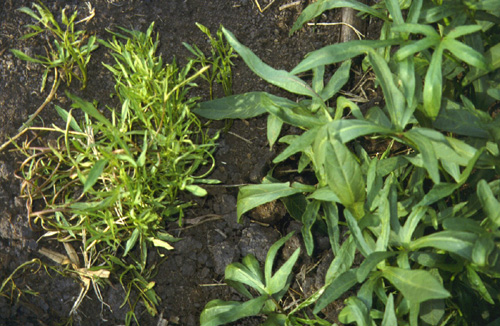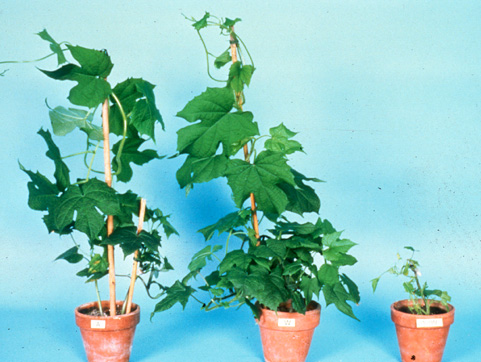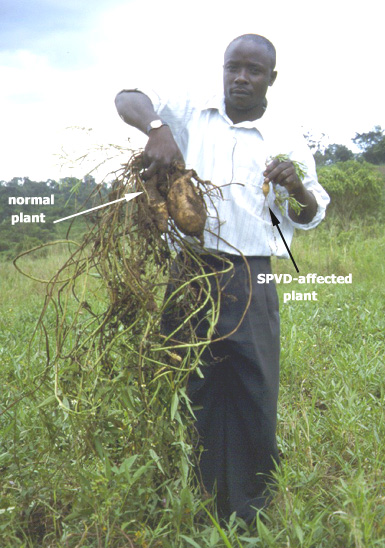|
This
is a disease complex caused by dual infection with the whitefly-transmitted crinivirus
sweetpotato chlorotic stunt virus (SPCSV) and the aphid-transmitted potyvirus
sweetpotato feathery mottle virus.
SPVD is the most damaging sweetpotato disease in Africa
and perhaps worldwide. It causes virtually
total yield loss in affected plants.
Throughout the tropics worldwide: particularly prevalent
in sub-Saharan Africa but recent reports of damage in South America too.
Diseased plants are severely stunted and the leaves are
small and narrow (strap-like or fan-like), often with a distorted edge. Puckering,
vein clearing, and mottling
may occur. The mottling is chlorotic so
that the whole plant may appear pale. Storage root development is affected
resulting to lower yield.
This disease is caused by SPCSV
synergistically breaking down resistance of sweetpotato against SPFMV,
allowing SPFMV to multiply some hundredfold more than when it
infects alone. This mechanism of synergism is currently unclear but is an area
of active research. SPCSV also synergises the infection of sweetpotato by other
viruses including cucumber mosaic virus and sweetpotato mild speckling virus.
Although the name SPVD is clearly non-specific, its use is best restricted to
describing only the disease caused by dual infection with SPCSV and SPFMV: other
names are generally used for diseases caused by other virus combinations.
Since SPCSV synergises SPFMV but not vice-versa, the
phenomenon of SPVD appears to have no effect on the spread of SPCSV but
enormously increases the ability of aphids to acquire and spread SPFMV as
suggested by results of studies on cultivar Tanzania and confirmed by
observations on other cultivars.
It is not clear whether SPCSV synergises infection of
SPFMV in any plant species other than sweetpotato.
The same methods as for SPFMV and SPCSV.
SPFMV is much more readily detected in SPVD-affected plants than in plants
infected with SPFMV alone.
Host plant resistance
No immunity has been identified in sweetpotato though
genotypes, with useful levels of resistance to infection in the field, have been
selected by farmers and plant breeders. Sweetpotato cultivars also vary in their
tolerance of SPVD.
Cultural control
Sanitation and selection by farmers of symptomless
planting material can help achieve control.
Ames, T., Smit, N.E.J.M., Braun, A.R., O’Sullivan, J.N., and Skoglund, L.G.
1996. Sweetpotato: Major pests diseases, and nutritional disorders.
International Potato Center (CIP). Lima, Perú. 152 p.
Aritua, V., Alicai, T., Adipala, E., Carey, E.E. and Gibson, R.W. 1998.
Aspects of resistance to sweet potato virus disease in sweetpotato. Annals of
Applied Biology 132:387-398.
Karyeija, R.F., Kreuze, J.F., Gibson, R. W. and Valkonen, J.P.T. 2000.
Synergistic interactions of a potyvirus and a phloem-limited crinivirus in sweet
potato plants. Virology 269:26-36.
Schaefers, G.A.
and Terry, E.R. 1976. Insect transmission of sweet potato disease agents in
Nigeria. Phytopathology 66:642-645.
Contributed
by: Nicole Smit and
Richard Gibson |
Disease
type
Economic
importance
Geographical
distribution
Symptoms
Biology
and ecology
Host
range
Detection
and inspection
Management
References

SPVD-affected
plant (left) showing small, pale green misshapen leaves with a
normal plant (right) (R.
Gibson).

Comparison of a plant infected with SPFMV only
(left) and with SPVD (right), displaying small, chlorotic, fan-like
leaves (J. Moyer).

Ipomoea setosa graft-inoculated with (left to
right) SPFMV, SPCSV and both agents, together causing SPVD (J. Moyer).

A sweetpotato plant with severe SPVD can virtually
have a total yield loss (R. Gibson).
|

